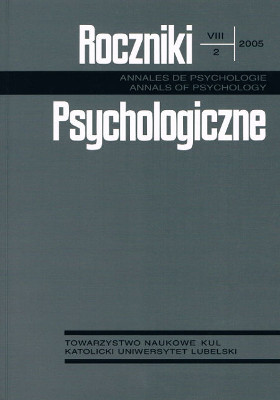Selected emotional disturbances following right hemispheric stroke
Abstract
The brain substrates of individual emotional processes and of their disorders are relatively poorly known. The objective of this study was evaluation of selected emotional disturbances following ischaemic stroke of the right hemisphere. The state of affect as well as the capability of visual and auditory recognition of emotion were characterised.
30 patients after the right hemispheric stroke and 31 healthy subjects took part in the study. The following instruments were utilised in the study: Hospital Anxiety and Depression Scale (Zigmond, Snaith, 1983), Mania Scale (Pużyński, 1979), Emotional Prosody Test from The Right Hemisphere Language Battery (Bryant, 1995; Łojek et al., 2000) and Facial Affect Recognition Test (Ekman, Friesen, 1976).
In patients with damage to the right hemisphere of the brain, emotional disorders of depressive and manic nature of varying severity were observed. A strong association was found between receptive prosody and the ability to recognice facial affect. The dissociation of emotional differentiation disorders was found with respect to the analysed modalities: visual recognition of joy and auditory recognition of sadness caused the least problems.
This study demonstrates the association between affective disturbances with right hemisphere damage. The results suggest an non-specific common machanism of emocional perception whose course is dependent on the content specification of a stimulus.
References
Borod, J. (1992). Interhemispheric and intrahemispheric control of emotion – a focus on unilateral brain damage. Journal of Consulting and Clinical Psychology, 60, 339-348.
Borod, J. (red.) (2000). Neuropsychology of emotion. New York–Oxford: Oxford University Press.
Borod, J., Obler, L. K., Erhan, H. M., Grunwald, I. S., Cicero, B. A., Welkowitz, J., Santschi, C., Agosti, R. M., Whalen, J. R. (1998). Right hemisphere emotional perception: Evidence across multiple channels. Neuropsychology, 12, 446-458.
Borod, J., Pick, L. H., Hall, S., Sliwinski, M., Madigan, N., Obler, L. K., Welkowitz, J., Canino, E., Erhan, H. M., Goral, M., Morrison, C., Tabert, M. (2000). Relationships among facial, prosodic, and lexical channels of emotional perceptual processing. Cognition and Emotion, 14, 193-211.
Bowers, D., Blonder, L., Feinberg, T., Heilman, K. M. (1991). Differential impact of right and left hemisphere lesions on facial emotion versus object imagery. Brain, 114, 2593-2609.
Bryan, K. L. (1995). The right hemisphere language battery. London: Whurr Publishers.
Brzeziński, J. (1980). Elementy metodologii badań psychologicznych. Warszawa: PWN.
Buck, R. (1984). Communication of emotion. New York: Guilford Press.
Ekman, P., Friesen, W. V. (1976). Measuring facial movements. Journal of Environmental Psycho-logy, 1, 56-75.
Etcoff, N. (1986). The neuropsychology of emotional expression. W: G. Goldstein, R. E. Tarter (red.), Advances in clinical neuropsychology (s. 127-179). New York: Plenum Press.
Gainotti, G. (1972). Emotional behavior and hemispheric side of the lesion. Cortex, 8, 41-55.
Heilman, K. M., Blonder, L. X., Bowers, D., Crucian, G. P. (2000). Neurological disorders and emotional dysfunction. W: J. Borod (red.), Neuropsychology of emotion (s. 367-412). New York–Oxford: Oxford University Press.
Heilman, K., Leon, S. A., Rosenbek, J. C. (2004). Affective aprosodia from a medial frontal stroke. Brain and Language, 89, 411-416.
Heilman, K. M., Valenstein, E. (2003). Clinical neuropsychology. New York–Oxford: Oxford University Press.
Herzyk, A. (1992). Asymetria i integracja półkulowa a zachowanie. Lublin: Wydawnictwo UMCS.
Herzyk, A., Borkowska, A. (red.) (1999). Neuropsychologia emocji: poglądy, badania, klinika. Lublin: Wydawnictwo UMCS.
Herzyk, A., Oszwa, U. (1992). Odbiór treści emocjonalnych przez pacjentów z jednostronnymi uszkodzeniami mózgu. Studia Psychologiczne, 30, 69-88.
Kądzielawa, D. (1985). Asymetria półkul mózgowych w zakresie emocji. Studia Psychologiczne, 24, 87-101.
Kucharska-Pietura, K., Klimkowski, M. (2002). Kliniczne aspekty emocji w zdrowym i chorym mózgu. Kraków: Wydawnictwo Medyczne.
Kucharska-Pietura, K., Philips, M. L., Gernand, W., David, A. S. (2003). Perception of emotions from faces and voices following unilateral brain damage. Neuropsychologia, 41, 1082-1090.
Łojek, E., Skotnicka, M., Bryan, K. L. (2000). Zestaw testów neuropsychologicznych do oceny zaburzeń językowych po uszkodzeniu prawej półkuli mózgu – wyniki badań wstępnych. Neurologia i Neurochirurgia Polska, 34, 71-81.
Majkowicz, M. (1994). The hospital anxiety and depression scale – HAD: kwestionariusz do badania lęku i depresji. W: De Walden-Gałuszko K., Majkowic M. (red.), Jakość życia w chorobie nowotworowej (s. 80-81). Gdańsk: Wydawnictwo Uniwersytetu Gdańskiego.
Posamentier, M. T., Abdi, H. (2003). Processing faces and facial expressions. Neuropsychology Review, 13, 113-143.
Pużyński, S. (1979). Skala oceny manii. W: A. Danysz (red.), Zasady i metody klinicznej oceny leków (s. 252-254). Warszawa: PZWL.
Pużyński, S. (2002). Depresja i zaburzenia afektywne. Warszawa: PZWL.
Robinson, R. (1998). The clinical neuropsychiatry of stroke – cognitive, behavioral and emotional disorders following vascular brain injury. New York: Cambridge University Press.
Rymarczyk, K. (1999). Zaburzenia prozodii emocjonalnej i lingwistycznej u pacjentów z uszkodzeniami mózgu. Przegląd Psychologiczny, 42, 135-150.
Szczygieł, D. (2002). Złożoność reprezentacji emocji – różnice między płciami (niepublikowana praca doktorska, Gdańsk).
Schmidt, J., Borod, J., Foldi, N. S., Sheth, S. J. (2004). Acoustical analysis and humen ratings of emotional prosody in unilateral stroke (abstract). W: 32nd INS Annual Meeting Program and Abstracts. Baltimore, s. 152.
Walsh, K. (1998). Neuropsychologia kliniczna. Warszawa: Wydawnictwo Naukowe PWN.
Zgaljardic, D. J., Borod, J. C., Sliwinski, M. (2002). Emotional perception in unilateral stroke patients: Recovery, test stability, and interchannel relationships. Applied Neuropsychology, 9, 159-172.
Zigmond, A. S., Snaith, R. P. (1983). The hospital anxiety and depression scale. Acta Psychiatrica Scandinavica, 67, 361-370.
Copyright (c) 2005 Roczniki Psychologiczne

This work is licensed under a Creative Commons Attribution-NonCommercial-NoDerivatives 4.0 International License.


